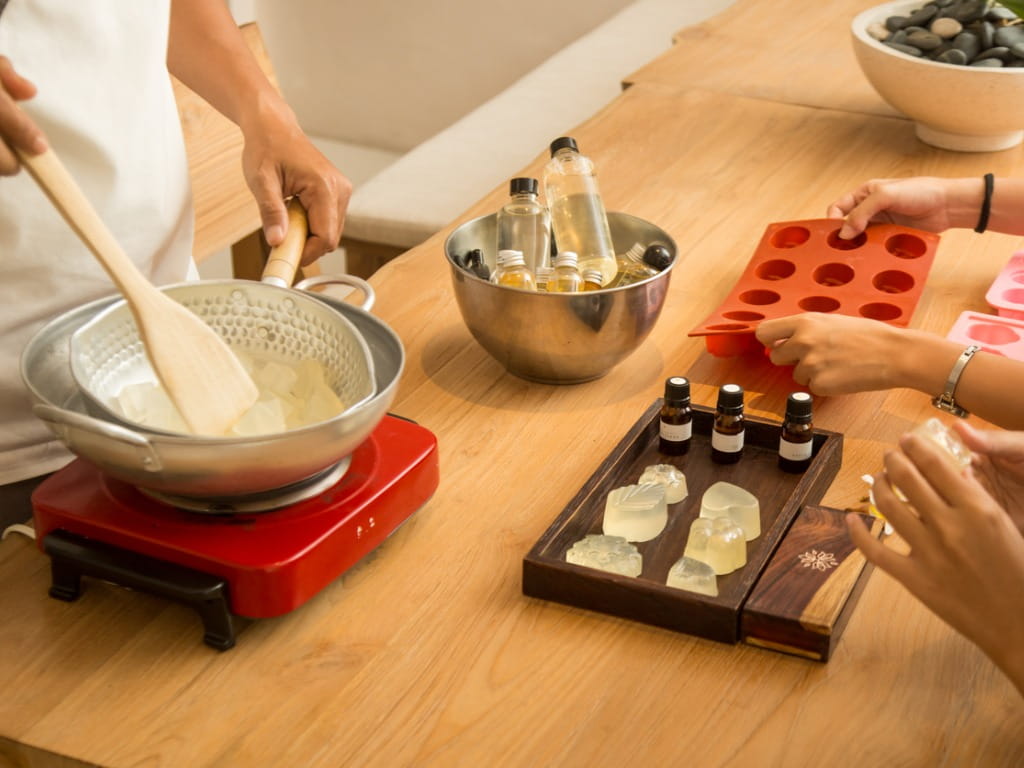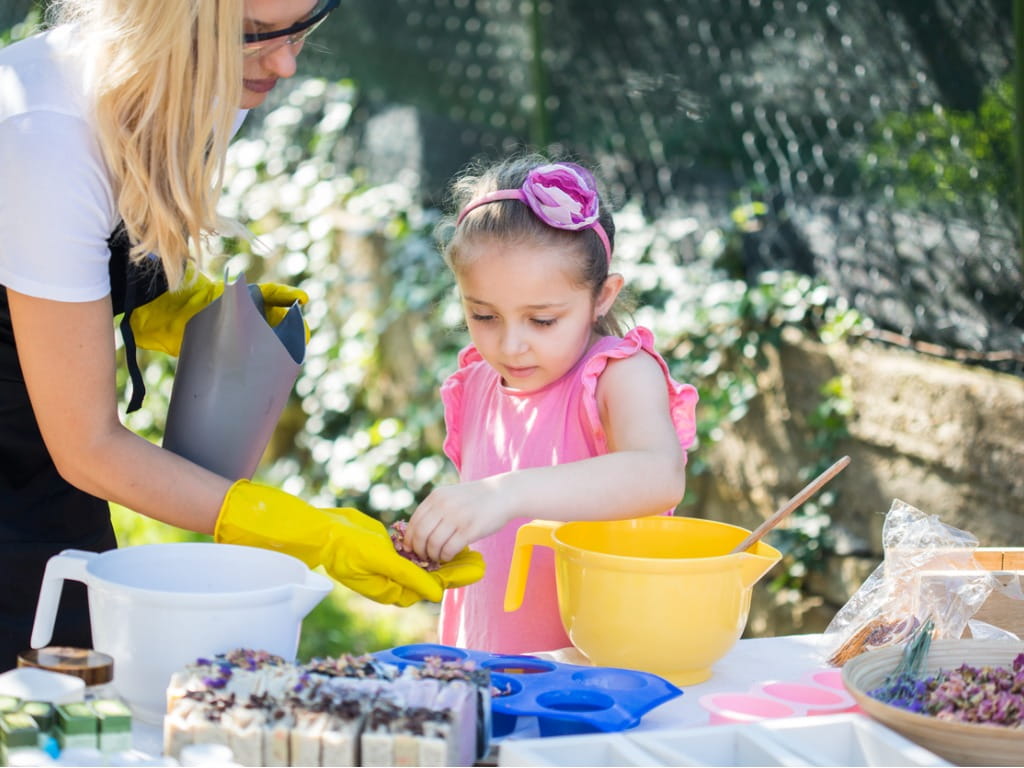Is It Safe to Make Soap at Home?

The Bottom Line
Soapmaking is a popular home activity, but potentially hazardous chemicals can be involved. Use of pre-made soap bases (“melt and pour” products) is a safer way to make homemade soap.

What are the origins of soap?
According to Roman legend, the first soaps were accidentally discovered around 3,000 years ago on Mount Sapo, a mythical mountain near Rome. After animals were sacrificed to please the Roman gods, the animals’ leftover fatty tissues, mixed with ashes of altar fires, ran downhill over the mountain. Women who visited the temple noted that when mixed with rainwater, the mixture of animal fat and ashes seemed to clean their clothes. Since then, the concept of combining fats and ashes remains an important part of soapmaking.
What is saponification?
Ashes are alkaline, which means that they have a high pH. When alkaline substance or alkaline material are combined with fats, a chemical reaction called saponification occurs. The process of saponification results in the formation of fatty acid salts, otherwise known as soap.
The alkaline product is ideally incorporated entirely into the saponification process, so there is no residual alkali left over in the finished soap product. Today, many soaps are made using a saponification process that incorporates lye (an alkaline chemical) and oil (a fat product).
Commercially manufactured soaps often contain other ingredients, including surfactants, plasticizers or binders, lather enhancers, and fragrance. Homemade soaps can be created with much simpler ingredients, including lye, oil, water, and (if desired) essential oils to add fragrance.
Is it hard to make your own soap?
The art of crafting homemade soap is increasing in popularity, and there are many instructional tutorials on making soap that are available on TikTok, YouTube, and other social media and online platforms. Many of these videos depict the soapmaking process as being deceptively easy: mix the chemicals together, add some fragrance, and pour the mixture into a silicone mold to harden. Despite the relatively simple recipes, however, it is important to know that the chemicals used in the soap-making process are potentially dangerous.
How dangerous is lye?
Lye, also known as caustic soda or sodium hydroxide, is a common ingredient in drain cleaners and is also present in some toilet bowl cleaning products. When human skin, eyes, or other tissues come into contact with lye, significant injuries can occur, including skin irritation, chemical burns, and blindness. Even though lye is odorless, irritation of the nose and throat can occur in people who breathe in lye mist or aerosols.
Lye is also potentially flammable, as it produces heat when dissolved in water. Although some social media videos depict people mixing soap-making ingredients without the use of gloves, this is not a good idea due to the highly irritating and corrosive properties of lye.
Lye should only be used in a well-ventilated area. Children are especially susceptible to the toxic effects of lye and should never be allowed to handle lye or come into close contact with it.
What if I get lye in my eye or on my skin?
Lye will burn any tissue it touches. People who get lye in their eyes or on their skin should wash the affected area(s) immediately with room-temperature water for at least 15–20 minutes. If a burning sensation or redness remains after rinsing, go to an urgent care center or emergency room for evaluation.
Can essential oils be harmful?
Essential oils are common ingredients in homemade soap. Essential oils are derived from the essence, or aromatic components, of plants. These oils can be used to provide fragrances for homemade soaps. Even though many essential oils have a very pleasant smell, they can be poisonous when swallowed, inhaled, or applied to the skin. When swallowed, many essential oils cause stomach irritation, nausea, or vomiting. However, some essential oils, including clove oil and lavender oil, can be much more poisonous when consumed. Even accidental ingestion of very small amounts of these oils can result in drowsiness, coma, and seizures.
Since children often do not realize that essential oils do not taste as good as they smell, ingestions of essential oils are common in toddlers and younger children and can be associated with severe toxicity. For this reason, it is very important to keep all essential oils well out of the reach of young children, including when making homemade soap.
In addition, while many people enjoy diffusing essential oils and inhaling their fragrance, some essential oils can be dangerous when high concentrations are inhaled. People with asthma or underlying lung disease can experience difficulties in breathing, coughing, or other respiratory symptoms after inhaling essential oil fragrances.
Skin irritation, including allergic contact dermatitis, can occur after topical application of essential oils. People who have sensitive skin should not apply essential oils to their skin or use these products when making homemade soaps.
What is the safest way to make soap at home?
Fortunately, there is a way to create homemade soap while minimizing exposure to lye. Pre-made soap bases (also known as “melt and pour” products) are available for purchase online and at craft stores. These products have already undergone saponification, so there is no need to add lye. The pre-made soap bases can be melted, infused with dyes or fragrances if desired, and poured into molds to create soap.
If you develop concerning reactions after exposure to essential oils or lye, Poison Control is available to help. Get online help using the webPOISONCONTROL tool or call 1-800-222-1222. Both options are free, confidential, and available 24 hours a day.
Kelly Johnson-Arbor, MD
Medical Toxicologist
Revised William G. Troutman, PharmD
Professor of Pharmacy Emeritus
Poisoned?
Call 1-800-222-1222 or
Prevention Tips
- Keep lye, essential oils, and other soap ingredients safely stored where children cannot see or reach them.
- Always make soap in a well-ventilated area.
- When using lye, always wear personal protective equipment, including masks, goggles, and gloves.
- Use pre-made soap bases (“melt-and-pour” products) as a safer option when making soap at home.
This Really Happened
Six brands of sodium hydroxide and potassium hydroxide were recalled by their manufacturer in 2020 due to a lack of child-resistant packaging. The recalled products were packaged in clear plastic bottles and were sold for the purposes of home soapmaking as well as drain cleaning. The US Consumer Product Safety Commission received reports of chemical burn injuries that occurred due to the use of the products.
For More Information
Beginner’s guide to melt and pour. Bramble Berry. Accessed May 18, 2025.
References
Poisoned?
Call 1-800-222-1222 or
Prevention Tips
- Keep lye, essential oils, and other soap ingredients safely stored where children cannot see or reach them.
- Always make soap in a well-ventilated area.
- When using lye, always wear personal protective equipment, including masks, goggles, and gloves.
- Use pre-made soap bases (“melt-and-pour” products) as a safer option when making soap at home.
This Really Happened
Six brands of sodium hydroxide and potassium hydroxide were recalled by their manufacturer in 2020 due to a lack of child-resistant packaging. The recalled products were packaged in clear plastic bottles and were sold for the purposes of home soapmaking as well as drain cleaning. The US Consumer Product Safety Commission received reports of chemical burn injuries that occurred due to the use of the products.
